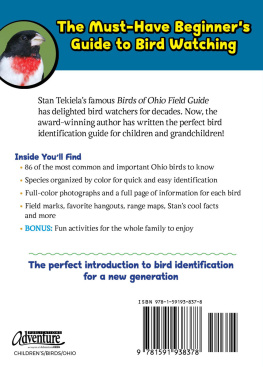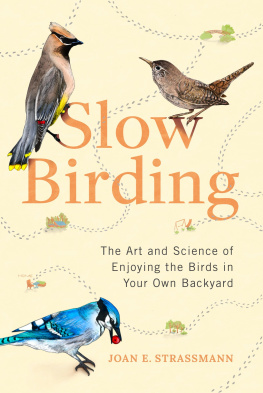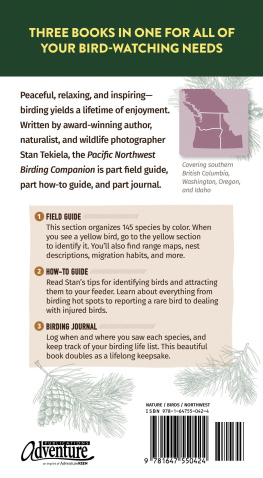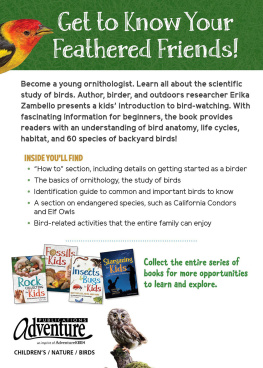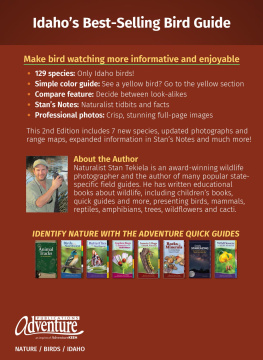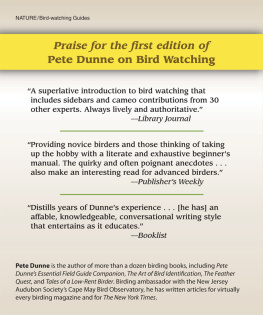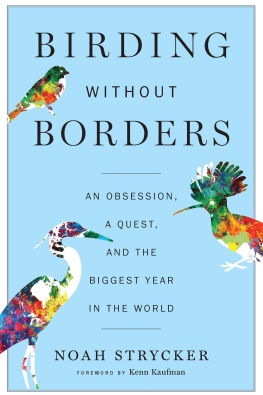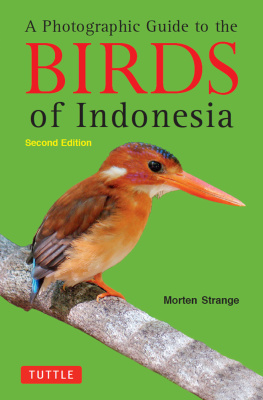
Copyright 2009 by Olivia Gentile
Illustrations copyright 2009 by Rebecca Layton
Electronic edition published in July 2009
All photographs are courtesy of the Snetsinger family.
Excerpts from Phoebe Snetsingers personal papers and published and unpublished writing used by permission of the Snetsinger family. Grateful acknowledgment is also made to the American Birding Association for permission to excerpt Phoebe Snetsingers writings and to the Leo Burnett Company for permission to excerpt Leo Burnetts speeches, writings, and biography, all of which are copyright 1995 Leo Burnett Company, Inc. All rights reserved. Used with permission.
All rights reserved. No part of this book may be reproduced or transmitted in any form or by any means, electronic or mechanical, including photocopying, recording, or by any information storage and retrieval system, without permission in writing from the publisher.
For information address Bloomsbury USA, 175 Fifth Avenue, New York, NY 10010.
Published by Bloomsbury USA, New York
LIBRARY OF CONGRESS CATALOGING-IN-PUBLICATION DATA
Gentile, Olivia.
Life list : a womans quest for the worlds most amazing birds/Olivia Gentile.1st U.S. ed.
p. cm.
ISBN: 978-1-60819-146-8 (ebook)
1. Snetsinger, Phoebe, 19311999. 2. Bird watchersUnited StatesBiography. 3. Bird watching. I. Title.
QL31.S557G46 2008
598.072'34dc22
[B] 2008027036
For my grandmother, Dorothy Fischer
WHEN I WAS twenty-three, I fell in love with a bird-watcher. Id just finished college and was living in rural Vermont, notbecause I loved mountains and open space but because Id gotten a job as a reporter at a small-town newspaper. I was skeptical,in fact, about mountains and open space. Most of my friends had moved to New York City when we graduated, and I would have,too, if a newspaper there had only hired me. Instead of writing about the election between Bill Clinton and Bob Dole and theemergence of capitalist China, the sort of work Id fantasized about when I decided to be a journalist, I was writing aboutthe new ice cream cart that had set up shop in the town of Springfield and the county prosecutor whod been arrested for drunkdriving.
I met Tait through a friend at the paper. He had big blue eyes, lots of curly blond hair, and a gentle, almost angelic wayabout him. He was a few years older than I was, and when I asked him what hed been doing since college, he said hed mostlybeen studying birds, as a field assistant for various research projects. One summer, hed lived in a tent on top of a mountainin Vermont, in a spruce forest, and observed the behavior of the rare and reclusive Bicknells Thrush; not long after that,he was sent to Panama, where he tried to figure out whether the Slate-throated Redstart could nest in the sparse trees onshaded coffee plantations.
When he wasnt working, he watched birds for fun, in the ponds, swamps, and woods near his house. By watched birds, I dontmean that he sat around, like you do when you watch TV. Bird-watching, the way most people do it, is a lot like hunting, whichis why some practitioners prefer the more active-sounding term birding: you have to know where and when to look for birds,you have to chase them down, and, when you find them, you have to figure out what species they areoften in just a secondor two, before they fly away. Tait, like most birders, kept a life list of all the species hed seen and identified, andhe was always looking to add new ones, or life birds.
He told me hed gotten interested in birds when he was about ten and his mother set up a birdfeeder outside their kitchenwindow. At the time, she was home-schooling him, and she asked him to take an inventory of all the birds and other animalsin their town. One of the first natural history books ever published was The Natural Historyand Antiquities of Selborne, an account of the flora and fauna in an English township by the local pastor, Gilbert White; the book later came to be knownsimply as Whites Selborne. As an homage, little Tait called his inventory, which was written in pencil on lined paper,Taits Bartonsville. A few years later, he got a scholarship to attend a boarding school in upstate New York, where he wasshy with his peers but was encouraged by his teachers to walk in the woods and fields and look for birds.
Id never given birds a moment of my attention. But when I looked through Taits binoculars, I saw their subtle loveliness:the lemon yellow of a warblers breast; the slow wing-beat of a hawk in flight; the curl of a herons long, slender neck.Through Tait, I also learned to hear birdstheir hoots, chuckles, trills, and cawsand it dawned on me that they were everywhere,even in winter, when the world looked barren. I learned, too, that birds had evolved from a small two-legged dinosaur calleda theropod, which grew feathers, probably to keep warm, and which eventually used those feathers to take to the air. Theresno need for fantasies like Jurassic Park: every time you see a bird, even a crummy little sparrow, youre looking at whats left of the dinosaurs.
I was so taken with Tait and his passion for the natural world that it took me a while to recognize his depression. It slowedhim down almost every day, and when it was bad, it paralyzed him. Hed forget things, pace, sleep too much, and cry. Hedbeen on and off medication for a while, he told me, but it never seemed to do much good.
All the same, every morning just before dawn, even when he was at his worst, he woke up to listen to the birdsong. Hed lieon his back in the purple-gray dark, eyes open and alert, and sift through the chorus to identify each species. If I was awake,he whispered the names of the birds so I, too, could appreciate the music. His connection to nature was so powerful, I realized,that it penetrated his depression better than medicine could, better than I could. I wondered if he would be alive withoutit.
We eventually broke up, which was crushing to both of us. He was still on my mind several years later, when I was studyingwriting in New York City. Most people barely notice birds, even in bucolic Vermont. Why had they come into focus for Tait?Had he already been depressed when they did? Why, exactly, did they soothe him so? The other birdwatchers Id met throughTait seemed to approach the pursuit with similar ardor. Did they need salvation too?
I decided to write some sort of essay on birdwatching, and I called a few bird clubs near my home in Manhattan to see whatthey had going on. One man misunderstood and thought I was interested in joining his club. He tried to encourage me. Whoknows? he said. Maybe youll be the next Phoebe Snetsinger. The man had never met Phoebe, but he knew all about herasmost bird-watchers do, it turned outand he told me a little. That was back in 2001, two years after her death, and Ive beenpiecing together her life ever since.
Phoebe wasnt meant to be a housewife. Her father was Leo Burnett, founder of one of the biggest advertising agencies in thecountry (the Leo Burnett Company, in Chicago), and she inherited his intensity and drive. As a little girl in the 1930s, shewas a tomboy who zealously memorized baseball statistics; when she was a teenager, in the 1940s, she wanted to be a psychologist,then changed her mind and decided to be a chemist. By the time she graduated from college, though, it was the era of Ozzieand Harriet. Earlier in the century, women had broken down all kinds of barriers, but in the postwar years there was a backlash:women were once again supposed to marry young, have as many kids as possible, and devote themselves entirely to their families.A few women tried to flout the norm and take up careers instead, but most of them didnt make it very far.



